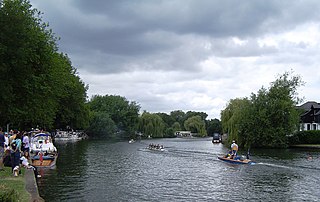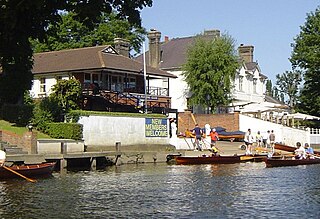
Rowing, sometimes called crew in the United States, is the sport of racing boats using oars. It differs from paddling sports in that rowing oars are attached to the boat using oarlocks, while paddles are not connected to the boat. Rowing is divided into two disciplines: sculling and sweep rowing. In sculling, each rower holds two oars—one in each hand, while in sweep rowing each rower holds one oar with both hands. There are several boat classes in which athletes may compete, ranging from single sculls, occupied by one person, to shells with eight rowers and a coxswain, called eights. There are a wide variety of course types and formats of racing, but most elite and championship level racing is conducted on calm water courses 2 kilometres (1.2 mi) long with several lanes marked using buoys.
A skiff is any of a variety of essentially unrelated styles of small boats. Traditionally, these are coastal craft or river craft used for leisure, as a utility craft, and for fishing, and have a one-person or small crew. Sailing skiffs have developed into high performance competitive classes. Many of today's skiff classes are based in Australia and New Zealand in the form of 12 ft (3.66 m), 13 ft (3.96 m), 16 ft (4.88 m) and 18 ft (5.49 m) skiffs. The 29er, 49er, SKUD and Musto Skiff are all considered to have developed from the skiff concept, all of which are sailed internationally.

A punt is a flat-bottomed boat with a square-cut bow, designed for use in small rivers and shallow water. Punting is boating in a punt; the punter propels the punt by pushing against the river bed with a pole. Punts were originally built as cargo boats and as platforms for fowling and for fishing, such as angling; whereas now punting is boating for pleasure.

Coastal and offshore rowing is a rowing sport performed at sea. In North America, this sport is often called open water rowing.

Harry Clasper was a professional rower and boat builder from Tyneside in England. He was an innovative boat designer who pioneered the development of the racing shell and the use of outriggers. He is said to have invented spoon-shaped oars.

The Sunbury Amateur Regatta is a regatta on the River Thames at Sunbury-on-Thames, Surrey, England with a rare visitors' boats lights display and fireworks event. It is for mainly traditional wooden types of boats with a few events for small sculling boats since its instigation in 1877 taking place by convention on a Saturday in early to mid August. The Edith Topsfield Junior Regatta takes place the following day.

Dongola racing is a popular event in traditional local regattas, especially on the River Thames in southern England and was first competed at Maidenhead in 1886. Competitors use wide punts and a team of people with single-bladed paddles, facing forwards and kneeling, normally with one leg up and one leg down. The person at the rear is responsible for the steering with their paddle.

Weybridge Rowing Club, founded in 1881, is a rowing club by the Thames in England, on the Surrey bank. The club organises head races, notably the Weybridge Silver Sculls which has had Olympian winners and co-organises a May/June regatta. It consists of a wide range of members: juniors, novices, seniors, masters (veterans) – these include many past and present champions.
A Thames skiff is a traditional River Thames wooden rowing boat used for skiffing. These boats evolved from Thames wherries in the Victorian era to meet a passion for river exploration and leisure outings on the water.

A single scull, abbreviated as a 1x, is a racing shell designed for a single person who propels the boat with two oars, one in each hand.

Sunbury Lock is a lock complex of the River Thames in England near Walton-on-Thames in north-west Surrey, the third lowest of forty four on the non-tidal reaches. The complex adjoins the right, southern bank about 1⁄2 mile (0.80 km) downstream of the Weir Hotel.
The Thames is one of the main rowing rivers in Europe. Several annual competitions are held along its course, including the Henley Royal Regatta, The Boat Race and other long-distance events, called Head of the River races (Heads).
The Skiff Club is the oldest skiff and punting club in existence, having been founded in 1895. It is based on the River Thames in London, on the Middlesex bank between Teddington Lock and Kingston upon Thames.

Thames Valley Skiff Club is an English skiff and punting club, which was founded in 1923. It is based on the River Thames in England, on the Surrey bank between Sunbury Lock and Walton on Thames.

Egham Regatta is a rowing regatta on the River Thames in England which takes place at the end of June on the reach above Bell Weir Lock near Egham, Surrey. The regatta is run from Wraysbury Skiff and Punting Club and the Runnymede Pleasure Grounds on the outskirts of Egham.
The Skiff Racing Association (SRA) is the governing body in the United Kingdom for the sport of skiff racing. The SRA is affiliated to British Rowing. The objectives of the SRA are

Wraysbury Skiff and Punting Club (WSPC) is an English skiff and punting club founded in 1931 based on the River Thames at the start of the Surrey section of the right bank – between the rest of Runnymede and Bell Weir Lock.
The Thames Punting Club (TPC) is the governing body in England for the sport of punt racing.

Dittons Skiff and Punting Club (DSPC or Dittons) is an English skiff and punting club, which was founded in 1923. It is based on the River Thames with a club and boat house at Thames Ditton on the reach above Teddington Lock. As well as taking part in regular skiff and punt racing competitions, crews from the club have established several rowing world records.

Hampton Court and Dittons Regatta is a regatta on the River Thames in England which takes place at Thames Ditton, Surrey beside Hampton Court Palace.


















